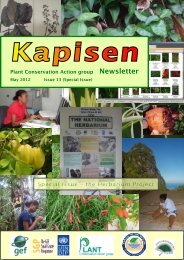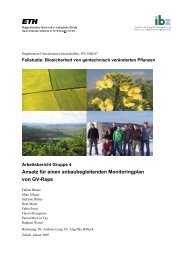Kapisen - ETH Zürich
Kapisen - ETH Zürich
Kapisen - ETH Zürich
Create successful ePaper yourself
Turn your PDF publications into a flip-book with our unique Google optimized e-Paper software.
Results<br />
I n v a s i v e C r e e p e r s<br />
Creeper abundance along roadsides<br />
33 alien and 5 native creeper species were collected<br />
and identified. Among the alien species 24 were<br />
rated as invasive. Their taxonomy and status can be<br />
seen in Tab. 1. In this study the most abundant alien<br />
creepers were Merremia peltata, Philodendron sp.,<br />
Philodendron lacerum, Epipremnum pinnatum “Aureum”,<br />
Syngonium podophyllum, Passiflora suberosa,<br />
and Ipomoea cairica.<br />
Invasive alien creeper species not yet abundant but<br />
showing the potential for invasions are Passiflora<br />
edulis, P. foetida, Ipomoea obscura, I. mauritiana,<br />
I. batatas, Porana paniculata, Thunbergia grandiflora<br />
and Antigonon leptopus. Alien creepers not yet<br />
abundant but very problematic in other countries of<br />
the Indian or Pacific Ocean are Antigonon leptopus,<br />
Hiptage benghalensis, Passiflora foetida, and Quisqualis<br />
indica.<br />
The results of the Pearson correlation test reveals that<br />
the abundance of creepers correlates positively with<br />
the number of habitations (p = 0.03, significant).<br />
Epipremnum pinnatum (S Katulic).<br />
1 http://www.geobot.ethz.ch/publications/books/bull/2003<br />
on this web page select „App. 2003-8 (K. Fleischmann &<br />
S. Katulic) (Link)”.<br />
Ipomea cairica (S Katulic).<br />
Creeper abundance in important biodiversity<br />
sites<br />
On Mahé creepers have started to invade important<br />
biodiversity sites. The relative abundance (as<br />
the percentage of all creepers found in an area<br />
investigated) of the alien creepers was as follows:<br />
Copolia: Merremia p. 34%, Syngonium p. 13%,<br />
Passiflora s. 13%, Vanilla p. 12%, Thunbergia g.<br />
4%, Ipomoea c. 3%, natives (Vanilla ph. & Nepenthes)<br />
21%.<br />
Mission Lodge: Thunbergia g. 40%, Ipomoea o.<br />
20%, Philodendron sp. 20%, Epipremnum a. 20%.<br />
Casse Dent: Vanilla p. 45%, Passiflora s. 14%, Philodendron<br />
sp. 3%, natives (Vanilla ph.) 38%.<br />
Mare aux Cochons: Merremia p. 29%, Vanilla p.<br />
19%, Syngonium p. 10%, Passiflora f. 6 %, Passiflora<br />
e. 5%, Ipomoea m. 5%, Ipomoea o. 4%, other<br />
alien creepers 11%, natives (Vanilla ph.) 11%.<br />
Montagne Palmiste: Vanilla p. 32%, Merremia p.<br />
30%, Passiflora s. 19%, Syngonium p. 6%, Porana<br />
p. 4%, other alien creepers 5%, natives (Vanilla ph.)<br />
4%.<br />
La Résèrve: Vanilla p. 57%, Ipomoea b. 14%, Merremia<br />
p. 14%, natives (Vanilla ph.) 15%.<br />
Congo Rouge: Merremia p. has been reported from<br />
this area as well (J. Mougal, A. Roucou & C. Kueffer,<br />
pers. comm.).<br />
Discussion<br />
This study shows that a high diversity of alien creepers<br />
has naturalized along roadsides on Mahé. The<br />
correlation between the number of habitations and<br />
the abundance of creepers indicates that gardens<br />
are a major starting point for creeper invasions. The<br />
high diversity and abundance of creepers along<br />
roads is especially problematic because many of<br />
these invasive creepers show already a tendency to<br />
invade biodiversity sites, e.g. Merremia p., Syngonium<br />
p., Passiflora spp., Ipomea spp., Thunbergia g..<br />
K a p i s e n 1 1 I s s u e 3







